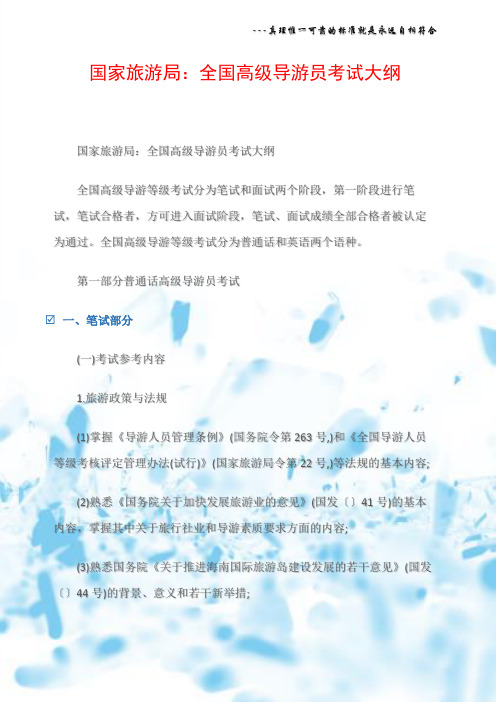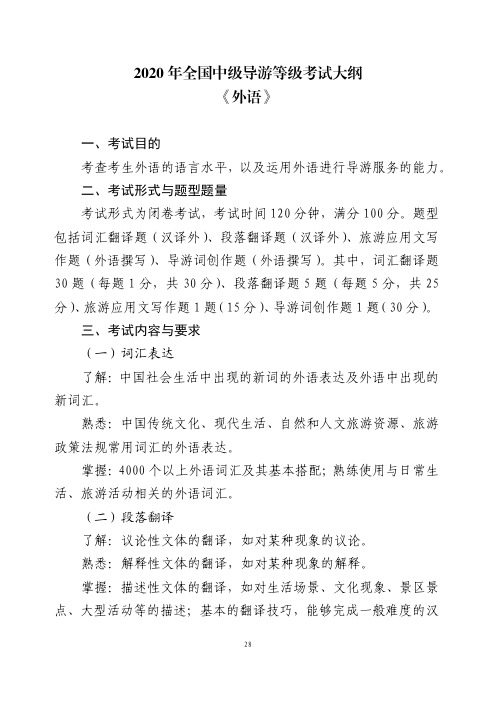导游英语考试大纲
- 格式:doc
- 大小:41.00 KB
- 文档页数:5

2016年全国导游人员资格考试大纲一、考试性质全国导游人员资格考试是为国家和社会选拔合格导游人才的全国统一考试。
考试的目标是以公平、公正的考试方式和方法,检验应试人员是否具有从事导游职业的基本知识、素养和技能。
根据《中华人民共和国旅游法》规定,参加全国导游人员资格考试成绩合格,及旅行社订立劳动合同或者在相关旅游行业组织注册的人员,可以申请取得导游证。
二、考试科目、语种及要求全国导游人员资格考试科目包括:科目一“政策及法律法规”、科目二“导游业务”、科目三“全国导游基础知识”、科目四“地方导游基础知识”、科目五“导游服务能力”。
考试语种分为中文和外语两种,其中外语类包括英语、韩语、日语、法语、德语、西班牙语、葡萄牙语、俄语等。
对上述科目内容,应试人员应分别从了解、熟悉、掌握等三个能力层次予以把握:——了解,要求对导游从业相关知识能够准确再认、再现,即知道“是什么”;——熟悉,在了解基础上,能够深刻领会导游从业相关知识及规定,并藉此解释、论证观点,分析现象,辨明正误,即明白“为什么”;——掌握,要求能够灵活运用导游从业相关知识和方法,综合分析、解决理论和实际问题,即清楚“怎么办”。
三、考试方式考试形式分笔试及现场考试两种,科目一、二、三、四为笔试,科目五为现场考试。
笔试科目实行机考,各地使用国家旅游局统一的计算机考试系统进行考试。
现场考试以室内模拟考试方式进行,由省级考试单位根据标准组织本行政区域内考试。
科目一、二合并为1张试卷进行测试,考试时间为90分钟,其中科目一、科目二所占比率各50%;科目三、四合并为1张试卷进行测试,考试时间为90分钟,其中科目四所占比率不少于50%。
考试题型均为客观题,分单项选择题和多项选择题两种。
单项选择题每题有四个选项,有且只有一个选项正确;多项选择题每题有五个选项,可能有二至四个选项正确。
每张试卷130题,其中单项选择题60题,每题0.5分,共30分;多项选择题70题,每题1分,共70分。

国家旅游局:全国高级导游员考试大纲国家旅游局:全国高级导游员考试大纲全国高级导游等级考试分为笔试和面试两个阶段,第一阶段进行笔试,笔试合格者,方可进入面试阶段,笔试、面试成绩全部合格者被认定为通过。
全国高级导游等级考试分为普通话和英语两个语种。
第一部分普通话高级导游员考试一、笔试部分(一)考试参考内容1.旅游政策与法规(1)掌握《导游人员管理条例》(国务院令第263号,)和《全国导游人员等级考核评定管理办法(试行)》(国家旅游局令第22号,)等法规的基本内容;(2)熟悉《国务院关于加快发展旅游业的意见》(国发〔〕41号)的基本内容,掌握其中关于旅行社业和导游素质要求方面的内容;(3)熟悉国务院《关于推进海南国际旅游岛建设发展的若干意见》(国发〔〕44号)的背景、意义和若干新举措;(4)掌握《旅行社条例》(国务院令第550号,)和《旅行社条例实施细则》(国家旅游局令第30号,)等的基本内容;(5)掌握《旅游投诉处理办法》(国家旅游局令第32号,)的基本内容;(6)了解《香港和澳门服务提供者在广东省设立旅行社申请审批办法》(国家旅游局、商务部令第29号,)的基本内容;(7)了解《大陆居民赴台湾地区旅游管理办法》(国家旅游局、公安部、国务院台湾事务办公室令第26号,)的基本内容。
2.重大时事对旅游业的影响(1)了解世界金融危机、自然灾害(如地震、海啸等)、流行性疾病(如非典、流感等)、区域性的恐怖活动或动乱等对旅游业的影响;(2)了解重大节庆活动(如世博会、奥运会等)对旅游业的影响。
3.旅游业态的发展状况(1)掌握旅游业在现代服务业中的地位与作用;(2)掌握特色旅游(如乡村旅游、低碳旅游、红色旅游、文化旅游等)的含义及实现方式;4.导游知识(1)了解中国基本国情和国策,熟悉民族、宗教、外交、环保等政策;(2)掌握旅游资源知识:中国旅游资源的基本分类和区域特征;中国被列入《世界遗产名录》的遗产概况、5A级景区的基本情况;(3)掌握旅游者知识:从性别、年龄、职业、客源地、文化背景、组织形式、消费方式、旅游目的等角度对旅游者进行分类。

江苏导游现场考试指南,英文,英语Navigating the Maze: A Guide to On-Site Tour Guide Examinations in JiangsuPreparing for an on-site tour guide examination in Jiangsu can feel like embarking on an adventure into uncharted territory. With a mix of excitement and trepidation, aspirants face the challenge of demonstrating their knowledge and skills in real-world settings. In this guide, we'll navigate through the intricacies of Jiangsu's tour guide examination process, offering insights and strategies to help you succeed.Understanding the Terrain: Examination Format and ContentBefore setting out on your journey, it's crucial to familiarize yourself with the terrain. Jiangsu's on-site tour guide examinations typically consist of a series of practical tasks designed to assess candidates' abilities to lead tours effectively. These tasks may include guiding a group through historical sites, cultural landmarks, ornatural attractions while providing informative commentary.Additionally, candidates may be evaluated on their communication skills, professionalism, and ability to handle unexpected challenges. As such, it's essential to not only have a deep understanding of Jiangsu's rich cultural heritage but also to cultivate stronginterpersonal skills and adaptability.Mapping Your Route: Preparation StrategiesTo navigate the complexities of the examination process, strategic preparation is key. Begin by conducting comprehensive research on Jiangsu's key tourist destinations, historical events, and cultural traditions. Familiarize yourself with notable landmarks, local customs, and points of interest, ensuring that you can provide insightful commentary and answer questions from visitors.Moreover, hone your communication skills by practicing delivering engaging and informative tours in both English and Mandarin. Consider recording yourself leading mocktours or participating in role-playing exercises to simulate real-world scenarios and build confidence in your abilities.In addition to content knowledge and communication skills, pay attention to professional conduct and etiquette. Dress appropriately for the occasion, maintain a friendly and approachable demeanor, and demonstrate respect for both the sites you visit and the individuals you interact with.Navigating Challenges: Adapting to the UnexpectedNo journey is without its challenges, and the same holds true for on-site tour guide examinations. Whether it's inclement weather, unforeseen logistical issues, or unexpected questions from visitors, candidates must remain calm, composed, and adaptable in the face of adversity.In such situations, rely on your knowledge, creativity, and problem-solving skills to navigate through obstacles gracefully. Be prepared to improvise, adjust your plans on the fly, and turn unexpected setbacks into opportunities toshowcase your resourcefulness and resilience.Remember, the ability to handle challenges with grace and professionalism is often just as important as content knowledge and technical skills in the eyes of examiners.Celebrating Success: Reflecting on the JourneyAs you reach the conclusion of your examination journey, take a moment to reflect on how far you've come and the lessons you've learned along the way. Whether you emerge victorious or encounter setbacks, every experience serves as a valuable stepping stone in your growth and development as a tour guide.Celebrate your achievements, no matter how small, and embrace the journey of continuous learning and improvement. With each examination attempt, you'll refine your skills, deepen your knowledge, and inch closer to your goal of becoming a certified tour guide in Jiangsu.In ConclusionNavigating the on-site tour guide examination process in Jiangsu requires a combination of preparation, adaptability, and resilience. By understanding the examination format, strategically preparing for challenges, and embracing opportunities for growth, you can embark on this journeywith confidence and determination.Remember, the path to success may be winding and unpredictable, but with dedication and perseverance, youcan navigate through any obstacle and emerge triumphant in your pursuit of becoming a certified tour guide in Jiangsu.。


江苏导游现场考试指南,英文,英语**Introduction**Welcome to Jiangsu, a province rich in history, culture, and natural beauty. As you prepare for your on-site tour guide examination, this guidebook aims to assist you in navigating the intricate details and requirements of the exam, ensuring a smooth and successful preparation process. **Exam Overview**The Jiangsu on-site tour guide examination consists of two main parts: a written test and an oral/practical exam. The written test focuses on knowledge of Jiangsu's history, culture, and tourism resources, while the oral/practical exam评估s candidates' communication skills, tour guidance abilities, and knowledge application in real-world scenarios.**Exam Preparation**1. **Study Materials**: Familiarize yourself withofficial exam guidelines and recommended study materials. Resources such as tourism books, guides, and onlineplatforms can provide valuable information on Jiangsu's tourist attractions, history, and culture. 2. **Practical Training**: Conduct mock tours and practice your讲解技巧in front of family or friends. This will help you become more confident and prepared for the actual exam. 3.**Language Proficiency**: As a tour guide, excellent communication skills are crucial. Practice speaking in English, focusing on clear pronunciation, fluent delivery, and accurate information presentation.**Exam Day**1. **Arrive Early**: Arrive at the exam venue well before the scheduled time to avoid any last-minute panic.2. **Dress Appropriately**: Dress in professional attire that reflects your commitment and respect for the exam.3.**Remain Calm**: Stay calm and composed during the exam. Be confident in your abilities and remember to smile.**Post-Exam**After the exam, take some time to reflect on your performance and identify areas for improvement. If you feel you have performed well, congratulations! If there are areas where you feel you could have improved, use this as an opportunity to learn and grow.**Conclusion**Preparing for the Jiangsu on-site tour guide examination can be challenging, but with the right guidance and dedication, success is achievable. Remember, the key is to stay focused, organized, and confident. With these tips, you are sure to ace your exam and embark on a rewarding career as a tour guide in Jiangsu.**江苏导游现场考试指南****考试概述**江苏导游现场考试主要包括两部分:笔试和口试/实践考试。

2020年全国中级导游等级考试大纲《外语》一、考试目的考查考生外语的语言水平,以及运用外语进行导游服务的能力。
二、考试形式与题型题量考试形式为闭卷考试,考试时间120分钟,满分100分。
题型包括词汇翻译题(汉译外)、段落翻译题(汉译外)、旅游应用文写作题(外语撰写)、导游词创作题(外语撰写)。
其中,词汇翻译题30题(每题1分,共30分)、段落翻译题5题(每题5分,共25分)、旅游应用文写作题1题(15分)、导游词创作题1题(30分)。
三、考试内容与要求(一)词汇表达了解:中国社会生活中出现的新词的外语表达及外语中出现的新词汇。
熟悉:中国传统文化、现代生活、自然和人文旅游资源、旅游政策法规常用词汇的外语表达。
掌握:4000个以上外语词汇及其基本搭配;熟练使用与日常生活、旅游活动相关的外语词汇。
(二)段落翻译了解:议论性文体的翻译,如对某种现象的议论。
熟悉:解释性文体的翻译,如对某种现象的解释。
掌握:描述性文体的翻译,如对生活场景、文化现象、景区景点、大型活动等的描述;基本的翻译技巧,能够完成一般难度的汉译外段落(50~80汉字/段)的翻译。
翻译要求译文忠实原文,无明显的错译、漏译;译文通顺,符合译入语的表达习惯,用词正确,无明显语法错误。
(三)旅游应用文写作了解:外语应用文写作。
熟悉:外语应用文书面表达技巧。
掌握:导游工作中常用外语旅游应用文的写作,包括电子邮件、通知、各种信函(邀请、预订、确认、感谢、申请、咨询等)、情况或工作汇报、投诉及回函、产品推介等。
写作要求行文流畅、格式正确、用词准确,符合外语的表达习惯。
(四)导游词创作了解:外语导游词写作特点。
熟悉:外语导游词的表达形式。
掌握:外语导游词的撰写技巧,能够就中国自然人文旅游资源中某一个专题撰写一篇400~600字的外语导游词,如某个景点景区、历史遗址、习俗节庆、建筑园林、饮食烹饪、茶叶酒品等。
创作要求语言规范、表达得体,符合导游语言要求及表达习惯;内容切题、条理清楚,有一定的思想深度。
2022甘肃省英语导游考试大纲一、语言知识要求考生掌握并能运用英语语音、词汇、语法基础知识以及所学功能意念和话题,要求词汇量为3500 左右。
二、语言运用1.听力要求考生能听懂所熟悉话题的简短独白和对话。
考生应能:(1)理解主旨要义;(2)获取具体的、事实性信息;(3)对所听内容做出推断;(4)理解说话者的意图、观点和态度。
2.阅读要求考生能读懂书、报、杂志中关于一般性话题的简短文段以及公告、说明、广告等,并能从中获取相关信息。
考生应能:(1)理解主旨要义;(2)理解文中具体信息;(3)根据上下文推断单词和短语的含义;(4)做出判断和推理;(5)理解文章的基本结构;(6)理解作者的意图、观点和态度。
3.写作要求考生根据提示进行书面表达。
考生应能:(1)清楚、连贯地传递信息,表达意思;(2)有效运用所学语言知识。
4.口语要求考生根据提示进行口头表达。
考生应能:(1)询问或传递事实性信息,表达意思和想法;(2)做到语音、语调自然;(3)做到语言运用得体;(4)使用有效的交际策略。
5. 基本读音(1) 26 个字母的读音(2) 元音字母在重读音节中的读音(3) 元音字母在轻读音节中的读音(4) 元音字母组合在重读音节中的读音(5) 常见的元音字母组合在轻读音节中的读音(6) 辅音字母组合的读音(7) 辅音连缀的读音(8) 成节音的读音6. 重音(1) 单词重音(2) 句子重音7. 读音的变化(1) 连读(2) 失去爆破(3) 弱读(4) 同化8. 语调与节奏(1) 意群与停顿(2) 语调(3) 节奏10. 语音、语调、重音、节奏等在口语交流中的运用11.朗诵和演讲中的语音技巧12主要英语国家的英语语音差异语法:1. 名词(1) 可数名词及其单复数(2) 不可数名词(3) 专有名词(4) 名词所有格2. 代词(1) 人称代词(2) 物主代词(3) 反身代词(4) 指示代词(5) 不定代词(6) 疑问代词3. 数词(1) 基数词(2) 序数词4. 介词和介词短语5. 连词6. 形容词(比较级和最高级)7. 副词(比较级和最高级)8. 冠词9. 动词(1) 动词的基本形式(2) 系动词(3) 及物动词和不及物动词(4) 助动词(5) 情态动词10. 时态(1) 一般现在时(2) 一般过去时(3) 一般将来时(4) 现在进行时(5) 过去进行时(6) 过去将来时(7) 将来进行时(8) 现在完成时(9) 过去完成时(10) 现在完成进行时11. 被动语态12. 非谓语动词(1) 动词不定式(2) 动词的-ing 形式(3) 动词的-ed 形式13. 构词法(1) 合成法(2) 派生法(3) 转化法(4) 缩写和简写14. 句子种类(1) 陈述句(2) 疑问句(3) 祈使句(4) 感叹句15. 句子成分(1) 主语(2) 谓语(3) 表语(4) 宾语(5) 定语(6) 状语(7) 补语16. 简单句的基本句型17. 主谓一致18. 并列复合句19. 主从复合句(1) 宾语从句(2) 状语从句(3) 定语从句(4) 主语从句(5) 表语从句20. 间接引语21. 省略22. 倒装23. 强调24. 虚拟语气功能意念:1. 社会交往(Social Communications)(1) 问候(Greetings)(2) 介绍(Introduction)(3) 告别(Farewells )(4) 感谢(Thanks )(5) 道歉(Apologies)(6) 邀请(Invitation)(7) 请求允许(Asking for permission)(8) 祝愿和祝贺(Expressing wishes and congratulations)(9) 提供帮助(Offering help)(10) 接受和拒绝(Acceptance and refusal)(11) 约会(Making appointments)(12) 打电话(Making telephone calls)(13) 就餐(Having meals)(14) 就医(Seeing the doctor)(15) 购物(Shopping)(16) 问路(Asking the way)(17) 谈论天气(Talking about weather)(18) 语言交际困难(Language difficulties in communication)(19) 提醒注意(Reminding)(20) 警告和禁止(Warning and prohibition)(21) 劝告(Advice)(22) 建议(Suggestions)2. 态度(Attitudes)(23) 同意和不同意(Agreement and disagreement)(24) 喜欢和不喜欢(Likes and dislikes)(25) 肯定和不肯定(Certainty and uncertainty)(26) 可能和不可能(Possibility and impossibility)(27) 能够和不能够(Ability and inability)8(28) 偏爱和优先选择(Preference)(29) 意愿和打算(Intentions and plans)(30) 希望和愿望(Hopes and wishes)(31) 表扬和鼓励(Praise and encouragement)(32) 责备和抱怨(Blame and complaint)(33) 冷淡(Indifference)(34) 判断与评价(Judgement and evaluation)3. 情感(Emotions)(35) 高兴(Happiness)(36) 惊奇(Surprise)(37) 忧虑(Worries)(38) 安慰(Reassurance)(39) 满意(Satisfaction)(40) 遗憾(Regret)(41) 同情(Sympathy)(42) 恐惧(Fear)(43) 愤怒(Anger)4. 时间(Time)(44) 时刻(Point of time)(45) 时段(Duration)(46) 频度(Frequency)(47) 时序(Sequence)5. 空间(Space)(48) 位置(Position)(49) 方向(Direction)(50) 距离(Distance)6. 存在(Existence)(51) 存在与不存在(Existence and Non-existence) 7. 特征(Features)(52) 形状(Shape)(53) 颜色(Colour)(54) 材料(Material)(55) 价格(Price)(56) 规格(Size)(57) 年龄(Age)8. 计量(Measurement)(58) 长度(Length)(59) 宽度(Width)(60) 高度(Height)(61) 数量(Number)9. 比较(Comparison)(62) 同级比较(Equal comparison)(63) 差别比较(Comparative and superlative)(64) 相似和差别(Similarity and difference)10. 逻辑关系(Logical relations)(65) 原因和结果(Cause and effect)(66) 目的(Purpose)11. 职业(Occupations)(67) 工作(Jobs)(68) 单位(Employer)短语:1. 个人情况(Personal information)2. 家庭、朋友与周围的人(Family, friends and people around)3. 周围的环境(Personal environments)4. 日常活动(Daily routines)5. 学校生活(School life)6. 兴趣与爱好(Interests and hobbies)7. 个人感情(Emotions)8. 人际关系(Interpersonal relationships)9. 计划与愿望(Plans and intentions)10. 节假日活动(Festivals, holidays and celebrations)11. 购物(Shopping)12. 饮食(Food and drink)13. 健康(Health)14. 天气(Weather)15. 文娱与体育(Entertainment and sports)16. 旅游和交通(Travel and transport)17. 语言学习(Language learning)18. 自然(Nature)19. 世界与环境(The world and the environment)20. 科普知识与现代技术(Popular science and modern technology)21. 热点话题(Topical issues)22. 历史与地理(History and geography)23. 社会(Society)24. 文学与艺术(Literature and art)。
导游考试大纲是指国家旅游局制定的导游考试的考试科目、考试内容、考试形式等方面的指导性文件。
以下是2023年导游考试大纲的主要内容:
一、考试科目
1. 导游业务知识
2. 旅游法律法规
3. 旅游文化知识
4. 旅游英语
二、考试内容
1. 导游业务知识
-旅游行业概述
-旅游市场营销
-导游服务流程
-导游职业道德和素质
-导游服务技能和方法
2. 旅游法律法规
-旅游法律基础知识
-旅游行政法规和部门规章
-旅游合同法律制度
-旅游安全和应急管理
3. 旅游文化知识
-世界文化遗产和非物质文化遗产
-中国传统文化和民俗风情
-旅游目的地历史文化背景
-旅游景点文化内涵
4. 旅游英语
-旅游英语词汇和表达能力
-旅游英语口语和听力能力
-旅游英语读写能力
三、考试形式
1. 笔试
-导游业务知识和旅游法律法规
-旅游文化知识和旅游英语
2. 面试
-导游服务技能和方法
-导游服务案例分析
-导游职业素养和应变能力
需要注意的是,导游考试大纲是考试的基础和指导,考生还需要结合实际情况和自身特点,制定合理的备考计划和策略,以达到考试的最佳效果。
科目一、二合并为1张试卷进行测试,考试时间为90分钟,其中科目一、科目二所占比率各50%;科目三、四合并为1张试卷进行测试,考试时间为90分钟,其中科目四所占比率不少于50%。
考试题型均为客观题,分单项选择题和多项选择题两种。
单项选择题每题有四个选项,有且只有一个选项正确;多项选择题每题有五个选项,可能有二至四个选项正确。
每张试卷130题,其中单项选择题60题,每题0.5分,共30分;多项选择题70题,每题1分,共70分。
外语类现场考试分为六大项:语言和礼貌仪态占30%,景点讲解占30%,导游服务规范占10%,应变能力占5%,综合知识占5%,口译占20%。
科目一:《政策与法律法规》大纲(一)考试目的通过本科目的考试,检查考生对党和国家的基本国策、根本制度、根本任务、重大方针政策以及相关法律、法规,旅游业发展的方针政策、办法等的了解、熟悉和掌握程度。
(二)考试内容1.熟悉《中华人民共和国宪法》(以下简称《宪法》)序言及总纲的内容,熟悉《宪法》规定的我国基本国策、根本制度、根本任务和国家机构,掌握《宪法》关于公民的基本权利和义务的规定,熟悉国旗、国歌、国徽和首都的规定。
2.了解《中共中央关于全面推进依法治国若干重大问题的决定》所提出的全面依法治国的重大意义、指导思想和总目标,熟悉依法治国的五大体系、六大任务;熟悉依法治旅的意义和措施。
3.熟悉《国务院关于加快发展旅游业的意见》(国发〔2009〕41号)、《国务院关于促进旅游业改革发展的若干意见》(国发〔2014〕31号)、《国民旅游休闲纲要(2013—2020年)》(国办发〔2013〕10号)和《关于进一步促进旅游投资和消费的若干意见》(国办发〔2015〕62号)的主要内容以及对我国旅游业发展的影响;了解我国旅游业“十三五”发展的指导思想、主要目标、规划指标、主要任务。
4.了解《中华人民共和国旅游法》(以下简称《旅游法》)的立法背景、框架,熟悉《旅游法》的立法目的、适用范围、发展原则等总则的内容,掌握《旅游法》的基本内容、主要法律制度及其相关法律责任。
《导游英语》教学大纲(38课时)一、课程性质和任务本课程是旅游英语专业学生的核心职业能力模块的课程。
本课程主要任务是培养、训练学生在旅游工作环境下英语听、说、读、写、译语言能力;并掌握系统的旅游、导游基础知识;熟悉了解国内外丰富的旅游资源。
该课程通过听、说、读、写、讨论、解决问题和角色扮演等教学手段培养学生从事旅游或涉外旅游管理专业所需的英语听力、口语、阅读理解和写作的基本专业英语技能。
通过教学,不仅要让学生全面了解旅游行业服务人员在各种相关涉外工作背景下,如:机场、旅行社、导游、酒店等常见的规范英语表达范例和常用表格、旅游文书写作指南,还要让学生从多角度了解中国灿烂的传统文化精髓。
此外,还应注重对学生进行中西方文化知识拓展和综合素质训练所涉及的知识结构,如:历史文化,民族民俗风土人情和社交礼仪等知识。
二、课程教学目标1.本课程的教学总目标:使学生掌握基本的听、说、阅读、翻译、口语等技能,为学习专业知识、掌握专业技能、提高英语整体水平打下基础,并注意培养学生用英语思考的习惯,提高学生在旅游语境中运用英语的综合技能。
2. 基本知识教学目标:1)掌握基本的听力、阅读、口语、写作、翻译等技能。
2)在旅游语境中对话和翻译的训练。
3. 能力教学目标:1)听力能力要求:能基本听懂正常语速(每分钟120-160个单词)的一般旅游活动中的电话、对话等,并能结合具体语言环境,理解所听内容的深层含义,把握说话者的态度和意图。
2)阅读能力要求:能读懂中等难度的旅游英语文章,了解作者的观点和态度。
阅读速度为每分钟100-140个单词,理解准确率在75%以上。
3)口语能力要求:能用英语熟练在各种旅游工作场景下与相关人士沟通,解决问题。
语音、语调正确,语流连贯顺畅,表达基本得体。
4)写作能力要求:能够运用所学语言知识,写出符合国际旅游惯例、格式规范的一般性旅游实用文书等。
要能够做到中心思想明确、结构合理、语言得体。
5)英汉互译能力要求:能够翻译一般性旅游阅读材料。